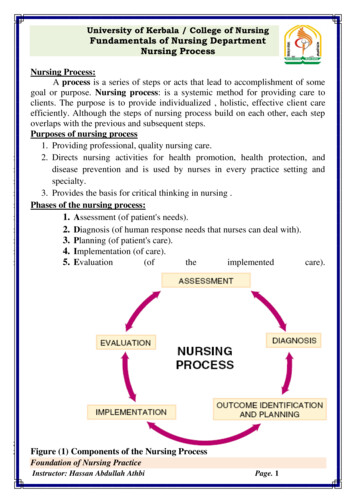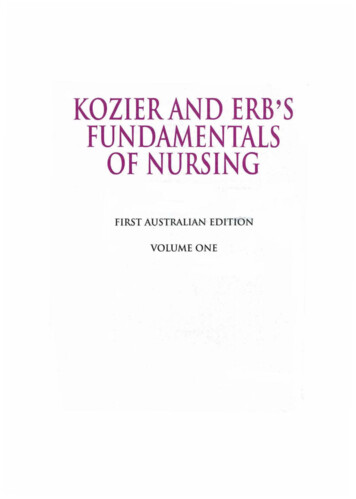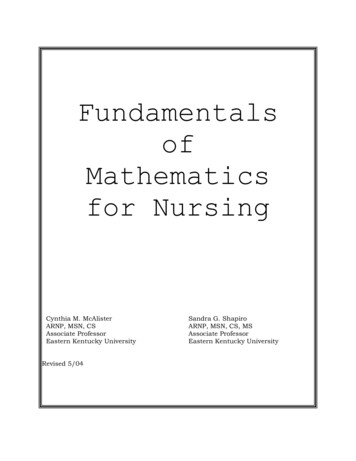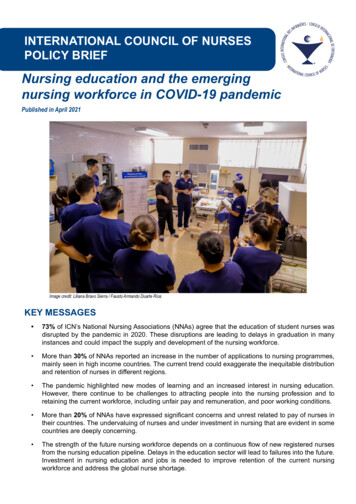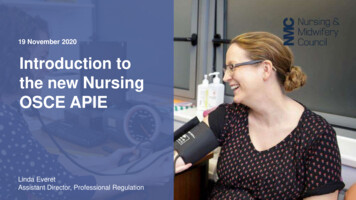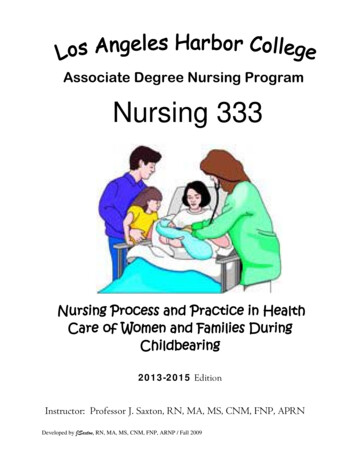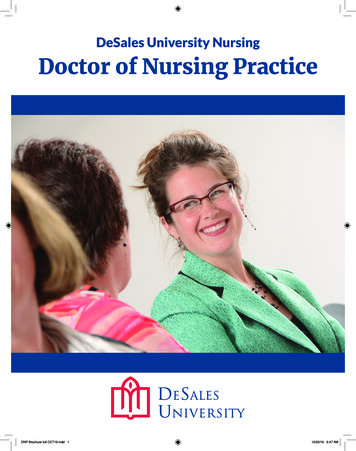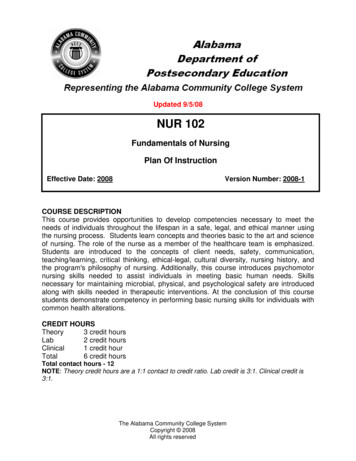
Transcription
Updated 9/5/08NUR 102Fundamentals of NursingPlan Of InstructionEffective Date: 2008Version Number: 2008-1COURSE DESCRIPTIONThis course provides opportunities to develop competencies necessary to meet theneeds of individuals throughout the lifespan in a safe, legal, and ethical manner usingthe nursing process. Students learn concepts and theories basic to the art and scienceof nursing. The role of the nurse as a member of the healthcare team is emphasized.Students are introduced to the concepts of client needs, safety, communication,teaching/learning, critical thinking, ethical-legal, cultural diversity, nursing history, andthe program's philosophy of nursing. Additionally, this course introduces psychomotornursing skills needed to assist individuals in meeting basic human needs. Skillsnecessary for maintaining microbial, physical, and psychological safety are introducedalong with skills needed in therapeutic interventions. At the conclusion of this coursestudents demonstrate competency in performing basic nursing skills for individuals withcommon health alterations.CREDIT HOURSTheory3 credit hoursLab2 credit hoursClinical1 credit hourTotal6 credit hoursTotal contact hours - 12NOTE: Theory credit hours are a 1:1 contact to credit ratio. Lab credit is 3:1. Clinical credit is3:1.The Alabama Community College SystemCopyright 2008All rights reserved
Fundamentals of NursingNUR 102PREREQUISITE COURSES BIO 103 – Principles of Biology I (or satisfactory performance on the Alabama CollegeSystem approved placement exam) NOTE: Only required if student is taking BIO 201 and202 sequences.CO-REQUISITE COURSES NUR 103 – Health Assessment NUR 104 – Introduction to Pharmacology BIO 201 – Human Anatomy and Physiology I or NUR 101 – Body Structure and Function Math requirementSUMMARY OF CHANGES: 9/5/08- Module Co Added Assisting with ambulation and Assistive devices to Module C clinical/labskills.o Changed “gastric feedings” to “gastric intubations” in clinical lab skills.- Module Jo Removed administration of other meds through tubes and associated learningobjectives.o Removed medications through nasogastric tubes from objective and added enteraland parenteral feeding and added learning objectives.o Realigned KSA indicators to match changes to learning objectives.INSTRUCTIONAL GOALS Cognitive - comprehend knowledge of nursing fundamentals and the nursing process. Performance - apply knowledge of nursing fundamentals and the nursing process in asimulated and clinical environment.PROFESSIONAL COMPETENCIES/OBJECTIVESUnless otherwise indicated, evaluation of student’s attainment of cognitive and performanceobjectives is based on knowledge and skills gained from this course. Competencies specifiedfor each module may be set by certification agencies, national and state codes, health carefacility policies, locally developed lab/clinical assignments, or any combination. Students areexpected to utilize relevant technology for client care and documentation.PROFESSIONAL COMPETENCIES Promote safe and secure environment. Assist clients with activities of daily living. Assess vital signs. Use therapeutic communication skills. Demonstrate professional behaviors. Provide needs-based care according to Maslow’s Hierarchy. Utilize the nursing process and critical thinking skills. Manage comfort, pain, sleep, and rest. Provide for nutrition/fluid balance. Administer medication through tubes. Maintain oxygenation. Promote, maintain, and restore elimination. Explain issues associated with the aging process.ACCS Copyright 2008All rights reserved2
Fundamentals of NursingNUR 102MODULE A – SAFETYPROFESSIONAL COMPETENCIESA1.0Promote safe and secureenvironment.PERFORMANCE OBJECTIVESA1.1 Provide environmental safety andsecurity.A1.2 Demonstrate aseptic techniques.A1.3 Demonstrate reporting proceduresand techniques for safety andsecurity.LEARNING OBJECTIVESA1.1.1 Identify safety risk factors.A1.1.2 Explain body mechanics risk factors.A1.1.3 Explain positioning, transfer, and ambulation.A1.1.4 Define environmental hazards.A1.1.5 Identify safety restraints.A1.1.6 Explain guidelines and risk factors for using safety restraints.A1.1.7 Explain the process of using safety restraints.A1.1.8 Identify the hazards of immobility.A1.1.9 Identify the nurse’s role in disaster management.A1.1.10 Identify issues related to risk management.A1.1.11 Explain the importance of risk management.A1.2.1 Identify types of asepsis.A1.2.2 Explain medical and surgical aseptic procedures including isolation.A1.2.3 Explain the chain of infection.A1.2.4 Explain the infectious process.A1.2.5 Explain the consequences of infection.A1.2.6 Explain the inflammatory process.A1.2.7 Identify diagnostic values related to inflammation and infection.A1.2.8 Identify OSHA guidelines for healthcare providers, including isolation.A1.2.9 Identify standard precautions.A1.3.1 Identify measures that ensure a secure environment.A1.3.2 Define documentation processes for safety and security.A1.3.3 Explain the process of reporting breaches in safety and security.CLINICAL/LAB SKILLS Safety and security measures Medical/Surgical asepsis (i.e. hand washing, dressing, sterile field, etc.) Lab values Restraints Body mechanics Range of motion Positioning, transfer and ambulation Assistive devices Personal protective equipment Safety documentation and reporting procedures Isolation techniquesACCS Copyright 2008All rights 3
Fundamentals of NursingNUR 102MODULE A OUTLINE Risk factors Body mechanics Mobility Assistive devices Environmental hazards Fire Electrical Mechanical Chemical Medical and surgical asepsis Lab values Safety devices (restraints) Guidelines Risk factors Procedures Disaster management Risk management issuesACCS Copyright 2008All rights reserved4
Fundamentals of NursingNUR 102MODULE B – INTEGUMENTARY SYSTEM ALTERATIONSPROFESSIONAL COMPETENCIESPERFORMANCE OBJECTIVESB1.0 Provide care for clients withselected integumentary systemalterations.Given clinical situations:B1.1 Assess a client for selectedintegumentary system alterations.B1.2 Develop a nursing care plan toprovide care for a client with selectedintegumentary system alterations.B1.3 Implement a nursing care plan toprovide care for a client with selectedintegumentary system alterations.B1.4 Evaluate the effectiveness ofinterventions for a client withintegumentary system alterations.LEARNING OBJECTIVESB1.1.1 Explain the anatomy and physiology of integumentary system.B1.1.2 Define terms associated with integumentary system alterations.B1.1.3 Identify causes of integumentary system alterations.B1.1.4 Describe diagnostic tests for selected integumentary system alterations.B1.1.5 Describe selected integumentary system alterations.B1.1.6 Interpret clinical manifestations to determine necessary care for selectedintegumentary system alterations.B1.2.1 Describe the pharmacological agents for selected integumentary systemalterations.B1.2.2 Describe nutritional considerations for treating selected integumentarysystem alterations.B1.2.3 Identify treatment modalities for selected integumentary systemalterations.B1.3.1 Describe the process for implementing a nursing care plan to treatselected integumentary system alterations.B1.4.1 Identify expected outcomes of treatment modalities for selectedintegumentary system alterations.B1.4.2 Use critical thinking to prioritize management of care.CLINICAL/LAB SKILLS Use of relevant technology for client care and documentation Therapeutic baths Hot and cold applications Wet to dry dressings Skin assessment Wound assessment Topical medications Decubitus careACCS Copyright 2008All rights reservedKSAIndicators2b2b2b2bBABBBCCCCcCD5
Fundamentals of NursingNUR 102MODULE B OUTLINE Terminology and A& P review Diagnostic tests Alterations Pressure ulcers (Decubitus) Inflammatory Infectious Skin cancers Nursing process Pharmacological agents Dermatological treatment Nutritional considerationsACCS Copyright 2008All rights reserved6
Fundamentals of NursingNUR 102MODULE C – ACTIVITIES OF DAILY LIVINGPROFESSIONAL COMPETENCIESC1.0Assist clients with activities ofdaily living.PERFORMANCE OBJECTIVESC1.1 Given scenarios and various clinicalsettings demonstrate assisting clientswith activities of daily living.KSAIndicator2bLEARNING .7Describe typical activities of daily living.Explain the process of providing hygiene.Identify special equipment for activities of daily living.Explain how to assist with toileting needs.Identify equipment and techniques to assist with mobility.Identify measures to maintain skin integrity.Describe measures that promote a therapeutic environment.BbabaaaCLINICAL/LAB SKILLS Bathing Bed making Hygienic care Toileting Assisting with ambulation Assistive devicesMODULE C OUTLINE Hygiene Toileting Mobility Skin Integrity Therapeutic environmentACCS Copyright 2008All rights reserved7
Fundamentals of NursingNUR 102MODULE D – VITAL SIGNSPROFESSIONAL COMPETENCIESD1.0Assess vital signs.PERFORMANCE OBJECTIVESGiven scenarios and various clinicalsettings:D1.1 Assess vital signs.D1.2 Document vital signs.KSAIndicator2b2bLEARNING OBJECTIVESD1.1.1 Define terminology related to assessing vital signs.D1.1.2 Identify equipment used for measuring temperature.D1.1.3 Explain the process for assessing temperature.D1.1.4 Identify equipment used for measuring pulse (central and peripheral).D1.1.5 Explain the process for measuring pulse (central and peripheral).D1.1.6 Identify equipment used for measuring respiration.D1.1.7 Explain the process for measuring respiration.D1.1.8 Identify equipment used for measuring blood pressure.D1.1.9 Explain the process of measuring blood pressure.D1.1.10 Identify assessment tools for measuring pain.D1.1.11 Explain the process of measuring pain.D1.1.12 Recognize abnormal findings.D1.1.13 Explain the relationship between vital sign measures.D1.2.1 Describe considerations for documenting vital signs.CLINICAL/LAB SKILLS Terminology Temperature Pulse Respiration Blood pressure Pain assessment Equipment Documentation and reportingMODULE D OUTLINE Temperature Pulse (central and peripheral) Respiration Blood Pressure PainACCS Copyright 2008All rights reservedAabababababBCc8
Fundamentals of NursingNUR 102MODULE E – THERAPEUTIC COMMUNICATION SKILLSPROFESSIONAL COMPETENCIESE1.0Use therapeutic communicationskills.PERFORMANCE OBJECTIVESGiven scenarios and various clinicalsettings:E1.1 Establish a therapeutic nurseclient/family relationship.E1.2 Demonstrate effectivecommunication skills.E1.3 Document and report clientinformation.E1.4 Demonstrate professionalcommunication among members ofthe healthcare team.KSAIndicator2b2b2b2bLEARNING OBJECTIVESE1.1.1E1.1.2E1.1.3Explain confidentiality.Define the nurse-client/family relationship.Explain the process of establishing and maintaining an effective nurseclient/family relationship.E1.2.1 Define communication.E1.2.2 Define therapeutic and non-therapeutic communication.E1.2.3 Differentiate between therapeutic and non-therapeutic communication.E1.2.4 Identify barriers to effective communication.E1.2.5 Explain how to overcome barriers to effective communication.E1.2.6 Identify basic concepts related to teaching and learning activities.E1.2.7 Describe considerations for performing teaching and learning activities.E1.3.1 Identify information to record.E1.3.2 Describe types and categories of documentation consistent withorganizational policy.E1.3.3 Explain the process of reporting and documenting client information.E1.4.1 Identify strategies to promote professional communication amonghealthcare team members.CLINICAL/LAB SKILLS Interaction analysis with client/family Documentation in medical records Confidentiality Provide and receive client reports Professional communication with healthcare teamMODULE E OUTLINE Establishing therapeutic nurse-client/family relationship Communication process Therapeutic/Non-Therapeutic communication Barriers to effective communication Documentation/reporting Communication among healthcare team membersACCS Copyright 2008All rights reservedBAbAABABcCBBbB9
Fundamentals of NursingNUR 102MODULE F – PROFESSIONAL BEHAVIORPROFESSIONAL COMPETENCIESF1.0 Demonstrate professionalbehaviors.PERFORMANCE OBJECTIVESF1.1 Given scenarios and variousclinical settings, demonstrateprofessional behaviorsassociated with nursing.LEARNING OBJECTIVESF1.1.1 Describe nursing from a historical perspective.F1.1.2 Identify the educational career paths available to nurses.F1.1.3 Describe competencies associated with each level of nursing.F1.1.4 Define the roles of the nurse as a provider of care, manager of care,and member of the discipline of nursing.F1.1.5 Identify the professional behaviors expected of nurses.F1.1.6 Identify caring behaviors associated with nursing.F1.1.7 Differentiate the scope of practice for LPNs and RNs as related toteaching and learning activities for the client, family, and community.F1.1.8 Explain the importance of adhering to standards of nursing practice.F1.1.9 Explain legal and ethical issues related to nursing.F1.1.10 Explain the importance of adhering to nursing program and healthcarefacility policies and procedures.F1.1.11 Describe the consequences of substance abuse by healthcareproviders.F1.1.12 Describe the nurse’s responsibilities in maintaining an environment freeof substance abuse.F1.1.13 State the roles of regulatory agencies, accrediting bodies andprofessional organizations related to nursing.CLINICAL/LAB SKILLS Standards of care Confidentiality Work ethic Dress and appearance Adherence to program/agency policies and proceduresACCS Copyright 2008All rights reservedKSAIndicator2bBABAAACBBBBBA10
Fundamentals of NursingNUR 102MODULE F OUTLINE History of nursing Nursing educational career paths Competencies of the nurse Professional behaviors Communication Caring interventions Teaching and learning Standards of nursing practice Legal/Ethical Legal terms and issues Ethical terms and issues Regulatory agencieso Alabama Board of Nursing Nurse Practice Acto Alabama State Board of Educationo Alabama Department of Public Health Accrediting bodies Professional organizationsACCS Copyright 2008All rights reserved11
Fundamentals of NursingNUR 102MODULE G – PROVIDING NEEDS-BASED CAREPROFESSIONAL COMPETENCIESG1.0PERFORMANCE OBJECTIVESProvide needs-based careG1.1 Given scenarios and variousaccording to Maslow’sclinical settings, provide needsHierarchy of Needs.based care for client/family.LEARNING OBJECTIVESG1.1.1 Define Maslow’s Hierarchy of Needs.G1.1.2 Describe needs throughout the lifespan.G1.1.3 Explain the impact culture and ethnicity can have on care during thelifespan.G1.1.4 Explain how spirituality can impact care during the lifespan.G1.1.5 Explain how sexuality can impact care during the lifespan.G1.1.6 Explain how anxiety, stress, and adaptation affect homeostasisthroughout the lifespan.G1.1.7 Describe the effect of grief and loss throughout the lifespan.G1.1.8 Describe considerations for recording client care.CLINICAL/LAB SKILLS Prioritize nursing care Individualize care based on client’s needs Postmortem care Documentation and recordingMODULE G OUTLINE Maslow’s Hierarchy of Needs Client/family lifespan Impact of culture, ethnicity, spirituality, and sexuality Effects of anxiety, stress and adaptation on homeostasis The impact of grief and loss Recording client careACCS Copyright 2008All rights reservedKSAIndicator1bABBBBBBc12
Fundamentals of NursingNUR 102MODULE H – NURSING PROCESS AND CRITICAL THINKINGPROFESSIONAL COMPETENCIESH1.0 Utilize the nursing process andcritical thinking skills.PERFORMANCE OBJECTIVESGiven scenarios and various clinicalsettings:H1.1 Apply the nursing process.H1.2 Demonstrate critical thinking whileproviding nursing care.LEARNING OBJECTIVESH1.1.1 Define the nursing process.H1.1.2 Identify the steps of the nursing process.H1.1.3 Identify data required for assessment and documentation.H1.1.4 Explain the process for gathering assessment data.H1.1.5 Explain the process for developing a nursing diagnosis using NorthAmerican Nursing Diagnosis Association (NANDA).H1.1.6 Review data to develop an acceptable NANDA nursing diagnosis.H1.1.7 Define the process for identifying goals.H1.1.8 Define a measurable goal.H1.1.9 Identify nursing interventions related to goal attainment.H1.1.10 Explain considerations for evaluating goal attainment.H1.2.1 Define the critical thinking process.H1.2.2 Use the critical thinking process to make decisions.CLINICAL/LAB SKILLS Develop nursing care plans Document and recordMODULE H OUTLINE Nursing process Assessments Planning Nursing diagnosis Implementation Evaluation Critical thinking and decision makingACCS Copyright 2008All rights reservedKSAIndicator1b1bAAAbBBaBABAD13
Fundamentals of NursingNUR 102MODULE I – COMFORT, PAIN, SLEEP, AND REST MANAGEMENTPROFESSIONAL COMPETENCIESI1.0Manage comfort, pain, sleep,and rest. (A/2b)PERFORMANCE OBJECTIVESI1.1I1.2Given scenarios and various clinicalsettings provide comfort measuresfor pain management, sleep andrest promotion.Apply the nursing process tomanage comfort, pain, sleep, andrest.LEARNING OBJECTIVESI1.1.1Define terms associated with comfort, pain, sleep, and rest.I1.1.2Explain techniques to promote comfort.I1.1.3Explain techniques to manage pain.I1.1.4Explain the process of promoting sleep.I1.1.5Explain the process of promoting rest.I1.2.1Explain the application of the nursing process in managing comfort, pain,sleep, and rest.CLINICAL/LAB SKILLS Hot and cold applications Relaxation techniques Manage environmental factors Time management and organizational skills Nursing process Document and recordMODULE I OUTLINE Comfort measures Pain management Sleep promotion Rest promotionACCS Copyright 2008All rights reservedKSAIndicator2b2bAbbbbb14
Fundamentals of NursingNUR 102MODULE J – NUTRITION/FLUID BALANCEPROFESSIONAL COMPETENCIESJ1.0 Provide nutrition/fluid balance.PERFORMANCE OBJECTIVESGiven scenarios and various clinicalsettings:J1.1 Apply the nursing process toproviding nutrition/fluid balanceacross the lifespan.J1.2 Demonstrate various methods forenteral and parenteral feeding.LEARNING OBJECTIVESJ1.1.1 Identify nutrition and fluid intake and output requirements across thelifespan.J1.1.2 Describe nutrition and fluid balance.J1.1.3 Differentiate between the value of various types of nutrients.J1.1.4 Explain roles of nutrients in the body.J1.1.5 Identify diagnostic values related to nutrition and fluid balance.J1.1.6 Identify food sources for nutrients.J1.1.7 Explain types of therapeutic diets.J1.1.8 Explain the relationship of prescribed diet to nutritional/fluid balance.J1.1.9 Identify equipment for measuring nutrition and fluid intake and output.J1.1.10 Calculate nutritional/fluid intake and output.J1.1.11 Explain the process of monitoring client nutritional intake and output.J1.1.12 Explain documentation requirements for nutrition and fluid intake andoutput.J1.2.1 Define enteral feedings.J1.2.2 Identify equipment used for enteral feedings.J1.2.3 Explain the procedure for initiating enteral feedings.J1.2.4 Explain the procedure for inserting a nasogastric tube.J1.2.5 Define parenteral therapy.J1.2.6 Describe equipment requirements for parenteral therapy.J1.2.7 Describe the types, purposes, operations of various GI tubes.ACCS Copyright 2008All rights reservedKSAIndicators1b1bAABBBBBBaCbBAabbAbc15
Fundamentals of NursingNUR 102CLINICAL/LAB SKILLS Intake and output Gastric feeding Insertion of nasogastric tubes Enteral and parenteral feeding Therapeutic diets Blood glucose monitoring Lab values Feedings Gavage Lavage Nursing process Document and recordMODULE J OUTLINE Intake and outputTherapeutic diets Feeding the clientEnteral nutritionNutrientsLab valuesParenteral therapyACCS Copyright 2008All rights reserved16
Fundamentals of NursingNUR 102MODULE K – MAINTAINING OXYGENATIONPROFESSIONAL COMPETENCIESK1.0Maintain oxygenation.PERFORMANCE OBJECTIVESGiven scenarios and various clinicalsettings:K1.1 Maintain airway.K1.2 Demonstrate emergencytechniques.K1.3 Apply the nursing process tomaintaining oxygenation.LEARNING OBJECTIVESK1.1.1 Define terms associated with oxygenation.K1.1.2 Explain the physiology of oxygenation.K1.1.3 Explain the process of oxygen administration.K1.1.4 Explain the process of nasopharyngeal suctioning.K1.1.5 Explain the process for specimen collection.K1.1.6 Identify diagnostic values related to oxygenation.K1.1.7 Explain pulse oximetry.K1.1.8 Explain the process of connecting a pulse oximeter.K1.2.1 Identify emergency techniques for restoring oxygenation.K1.2.2 Explain the process of using various emergency techniques for restoringoxygenation.K1.3 1 Explain the process of applying the nursing process to maintainingoxygenation.CLINICAL/LAB SKILLS Oxygen administration Pulse oximetry Nasopharyngeal suctioning techniques Specimen collection Lab values Cardiopulmonary Resuscitation (CPR) Nursing process Document and recordMODULE K OUTLINE Oxygen administration Nasopharyngeal suctioning Oxygen maintenance Lab values Pulse oximetry Emergency proceduresACCS Copyright 2008All rights reservedKSAIndicators1b1b1bABbbbBBbAbb17
Fundamentals of NursingNUR 102MODULE L – ELIMINATIONPROFESSIONAL COMPETENCIESL1.0Promote, maintain, and restoreelimination.PERFORMANCE OBJECTIVESGiven scenarios and various clinicalsettings:L1.1 Provide interventions to promote,maintain, and restore bowel/bladderelimination.L1.2 Apply the nursing process topromote, maintain, and restoreeliminationL1.3 Document and report interventions.LEARNING OBJECTIVESL11.1.1 Define terms associated with elimination.L1.1.2 Identify procedures for assisting with bowel/bladder elimination.L1.1.3 Identify equipment used for different types of catheterization.L1.1.4 Explain the procedures for different types of catheterization.L1.1.5 Identify types of bladder irrigation.L1.1.6 Identify equipment used for bladder irrigation.L1.1.7 Explain the procedures for bladder irrigation.L1.1.8 Identify types of specimen collection.L1.1.9 Identify equipment used for specimen collection.L1.1.10 Identify techniques for specimen collection.L1.1.11 Identify types of enemas.L1.1.12 Identify equipment used for different types of enemas.L1.1.13 Explain the procedures of performing an enema.L1.1.14 Explain procedures for removing fecal impactions.L1.1.15 Identify the types of ostomies.L1.1.16 Identify equipment used for different types of ostomy care.L1.1.17 Explain the procedures for types of ostomy care.L1.2.1 Explain the process of applying the nursing process to promote, maintain,and restore elimination.L1.3.1 Explain the process of documenting and reporting interventions related tobowel/bladder eliminations.CLINICAL/LAB SKILLS Catheterizations Catheter care Care of urinary diversions Bladder irrigations Specimen collections Lab values Ostomy care Enemas Fecal impaction removal Nursing process Documenting and reportingACCS Copyright 2008All rights reservedKSAIndicators1b1b1bAbabAabAabAabbAabbb18
Fundamentals of NursingNUR 102MODULE L OUTLINE Bowel/bladder elimination procedures Catheterization Bladder irrigation Urinary diversions Ostomy care Enema Specimen collection Lab valuesACCS Copyright 2008All rights reserved19
Fundamentals of NursingNUR 102MODULE M – AGING PROCESSPROFESSIONAL COMPETENCIESPERFORMANCE OBJECTIVESKSAIndicatorscM1.0 Explain issues associated with theM1.1 This module is measuredaging process.cognitively.LEARNING OBJECTIVESM1.1.1 Define terms associated with the older adultM1.1.2 Explain biological, sociological and psychological theories of aging.M1.1.3 Explain the most common psychosocial changes faced by older adults invarious cultures.M1.1.4 Explain current social problems/issues concerning the older adult.M1.1.5 Describe the most common methods of financing health care for the olderadult population in the country.M1.1.6 Describe the most common changes in physical appearance, bodysystem alterations and the nursing implications.M1.1.7 Explain ways in which the older adult can promote and maintain goodhealth.CLINICAL/LAB SKILLS NoneMODULE M OUTLINE Vocabulary Gerontology Geriatrics Osteoporosis Presbycusis Cataracts Osteomalacia Theories Psychosocial Changes Developmental tasks of the Older Adulto Changes in routineso Changes in housingo Fixed Income”o Family and Social relationships Personality changes seen with the older adult Current social problems/issues of the elderly as reported in the media Health Care – Who is paying? Physiological changes and Related Needs Altered Senses – taste, hearing, sight, touch and smell Appearance – Skin, hair, nails, gait Body System alterations – Body Temperature, Respiration, Circulation, Digestion,Elimination, Nervous system, Sexual changes Health Maintenance Accident prevention Adequate nutrition Adequate rest and exercise Independence and self-esteemACCS Copyright 2008All rights reservedABBBcBB20
Fundamentals of NursingNUR 102Learning Objectives Table of specificationsThe table below identifies the percentage of cognitive objectives for each module.Instructors should develop sufficient numbers of test items at the appropriatelevel of 3%44%57%54%74%42%83%55%82%47%72%Module AModule BModule CModule DModule EModule FModule GModule HModule IModule JModule KModule LModule MACCS Copyright 2008All rights %13%5%14%Evaluation/CompleteTheoryD/d8%8%-21
Fundamentals of NursingNUR 102Knowledge, Skills, and Attitudes (KSA) IndicatorsValueKey Word(s)HighlyProficientAffectiveKnowledgeKnowledge oficient1Limited Facts*5Characterization ingdcDefinitionPerforms competency quickly and accurately. Instructs others how to dothe competency.Performs all parts of the competency. Needs only a spot check ofcompleted work.Performs most parts of the competency. Needs help only on hardest parts.Performs simple parts of the competency. Needs to be told or shown howto do most of the competency.Predicts, isolates, and resolves problems about the competency.Identifies why and when the competency must be done and why each stepis needed.Determines step-by-step procedures for doing the competency.Names parts, tools, and simple facts about the competency.Evaluates conditions and makes proper decisions about the subject.Analyzes facts and principles and draws conclusions about the subject.Identifies relationship of basic facts and states general principles about thesubject.Identifies basic facts and terms about the subject.Acting consistently with the new valueIntegrating a new value into one's general set of values, giving it someranking among one's general prioritiesShowing some definite involvement or commitmentShowing some new behaviors as a result of experienceBeing aware of or attending to something in the environmentAlpha Scale Values - Any item with an upper case letter (A, B, C, D) by itself is taught as general information on a topic. This information may be related to thecompetency or encompass multiple competencies. Examples might include mathematical computations or knowledge of principles such as Ohm’s Law.A lower case letter indicates a level of ”Knowledge of Skills." Individuals are taught information pertaining to performing a competency . These may be indicatedalone or in conjunction with a numerical scale value. A lower case letter by itself indicates the individual is not required to perform the task-just know about the task.(example: Can state or explain procedures for doing a task).Numerical Scale Values - The numbers reflect the levels the individual will be able to perform a competency. Number values are always accompanied by lowercase letters (i.e. 1a, 2b, 3c.etc.) in order to specify the level of knowledge of skills associated with the competency.Example: An individual with a competency with a scale indicator of 3b has received training of knowledge of skills whereby he or she can determine the correctprocedures and perform with limited supervision; only requiring evaluation of the finished product or procedure.Asterisk items indicate desired affective domain levels and are used to indicate the desired level for a given competency. They may be used independently or withother indicators (i.e. 1a-*1, 2c-*3). If used with another indicator, separate with a hyphen.NOTE: Codes indicate terminal values.ACCS Copyright 2008All rights reserved22
F1.1.1 Describe nursing from a historical perspective. F1.1.2 Identify the educational career paths available to nurses. F1.1.3 Describe competencies associated with each level of nursing. F1.1.4 Define the roles of the nurse as a provider of care, manager of care, and member of File Size: 263KB



